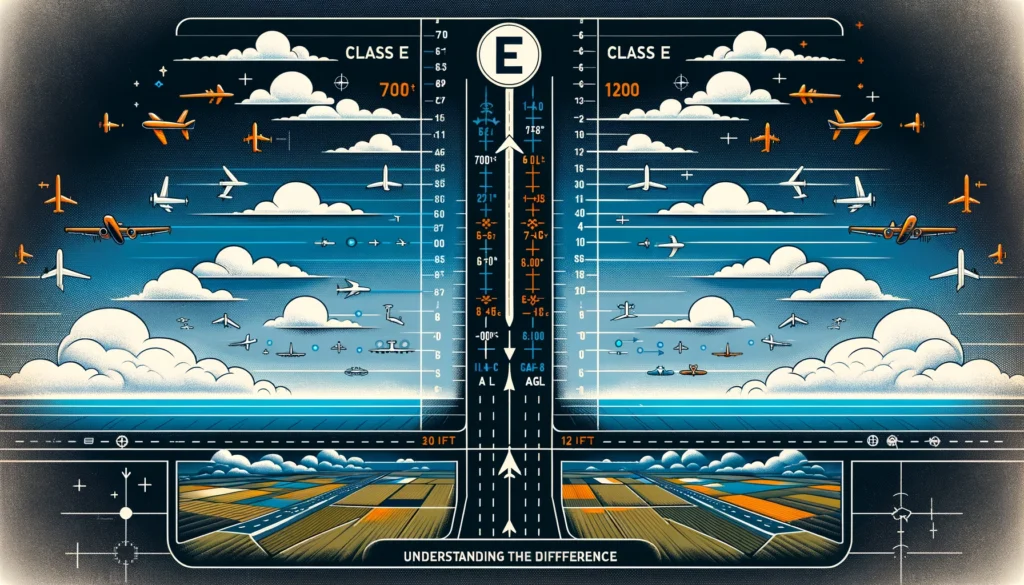When the sky calls, whether you’re a pilot or a drone enthusiast, understanding the invisible highways and byways above us is crucial. Today, let’s unravel the intricacies of Class E Airspace, a segment of the aerial tapestry that, while less discussed than its Class B or C cousins, Class E Airspace is vital for the safe and orderly flow of traffic overhead.
Class E Airspace: Discover Pilot’s Gateway to Freedom & Mastering the Sky’s Secret Paths Now!
What Is Class E Airspace?

Class E airspace is a class of airspace located on the air surface, usually at 700 feet or 1,200 feet above ground level (AGL). On the spot, VFR Pilots can do a lot of maneuvering since the atmosphere is free for them.
Unlike in a few classes of airspace, pilots don’t need explicit clearance from the Air Traffic Control (ATC) to enter Class E airspace. It indicates that VFR pilots can do their flying operations at their flexibility within the airspace without being bound to follow specific flight routes or be tied down to particular schedules. Yet that won’t suggest that the rules don’t apply anymore, only that there are slight variations from those on the ground.
In other words, Class E airspace is a specific type of airspace, that provides more convenience for pilots, They will have more control since they will no longer have to follow specific routes. They will still have to take care of safety, keeping the visibility and the distance from the clouds to ensure the skies are safe for everyone.
Class E Airspace Requirements: Knowing the Basics:
Class E airspace is a type of controlled airspace that ranges from up to 1,200 feet above ground level (AGL), but does not include, 18,000 feet MSL (mean sea level).
Although Class E airspace needs to be less demanding in its entry requirements, the pilots are still advised to ensure that they have the prerequisite knowledge and skills to fly in the airspace safely and confidently.
For VFR (Visual Flight Rules) pilots, the visibility and cloud clearance standards vary depending on the altitude. For example, if a pilot is flying below 10,000 feet MSL, they have to maintain at least 500 feet below, 1,000 feet above, and 2,000 feet horizontally from clouds. Nonetheless, if your pilot is above 10,000 feet MSL, they have to keep a distance of 1,000 feet below and above and 1 mile horizontally from the clouds.
Due to IFR, Airplanes do not need ATC clearance to enter Class E airspace, they are obliged to follow ATC instructions in the course of flight. ATC might give out sideways directions, altitude changes, and other commands to the aircraft so that the airspace is not congested by other aircraft present in that flying zone.
A pilot who is flying VFR or IFR would be better equipped to carry out a safe and effective flight if they are familiar with the regulations and requirements of Class E airspace.
Understanding Class E Airspace on a Sectional Chart:
Being aware of the Class E airspace on a sectional chart is critical while doing flight planning since it assists the pilots in locating the areas in which they would have to abide by certain precautions or seek clearance from air traffic controllers. Sectional charts are maps that the pilots utilize for sky navigation. They hold complete data about Airports, Navaids, and airspace classifications.
As seen on sectional charts Class E airspace, includes information on the altitude at which the plane is flying, and this can be different at different places. For example, the Class E airspace may start at the surface level in some areas while it may start at less than 700 feet AGL or even higher at 1 200 AGL in other regions.

The starting point of Class E airspace is one of the critical points for pilots because it helps them plan their flights and keep within the right flying altitude. With the help of following the fuzzy lines that symbolize Class E airspace on the sectional chart, pilots can easily avoid entry into airspace where they are not authorized.
This is what keeps the skies safe and efficient for all pilots, thereby allowing them to reach their destination on time and conveniently.
The Shape-Shifting Dimensions of Class E Airspace:
E-class airspace is a flexible airspace with no fixed dimensions. Class E is often used at locations around the country, such as uncontrolled airports, prisons, or other sites that do not qualify for any of the other airspace classes. It features the capability to change while still accommodating the demand of the space is covering which implies that it is a highly flexible environment that supports different types of air operations ranging from small Mini drones to big commercial aircraft.
Such ability of shaping and sizing has created an aircraft dynamic airspace in which complicated aviation activities can be executed seamlessly, facilitating better airspace use. It is worth mentioning that this function and its unusual features are the reasons why Class E airspace plays a crucial role in the national airspace system of the country, as it ensures the safe, efficient, and uninterrupted management of transportation.
The Rules of the Sky in Class E Airspace:
The rules within Class E are designed to promote a delicate balance between freedom and order. VFR pilots enjoy the liberty of flight without strict paths, while IFR pilots are guided by ATC’s invisible hand, ensuring an organized flow of traffic in the skies.
Is Class E Airspace Controlled?
The FAA system has several types of controlled airspace, and Class E is one of them. No, it is not the strictest of all the controlled airspace, but it is still managed by Air Traffic Control (ATC).
The ATC’s control in Class E airspace is rather more of a guidance than a dominating function. Within this space, the air traffic controllers guide and instruct all aircraft flying IFR (instrument flight rules) to enhance their safety and efficiency.
For this, they use the radar to maintain contact and give the pilots directions as well as guidance. Contrariwise, VFR (visual flight rule) flights in Class E airspace have some more freedom.
However, they are still obligated to obey the visibility and cloud clearance rules of FARs (Federal Aviation Regulations). VFR pilots are responsible for themselves and should know their place and height.
Moreover, they need to keep track of their location and communicate with ATC. The crux of the matter is that Class E airspace is controlled, but it gives the freedom and flexibility of flying safely within the bounds of this air space.
It is critical for pilots to understand and follow the rules and standards when operating in Class E airspace and to use ATC communication whenever required to facilitate secure and efficient flight operations.
The Starting Point of Class E Airspace:
Airspace management is a complex function for a pilot, particularly when having to deal with controlled airspace. For example, Class E airspace is designed with a base altitude which changes depending on the location. The pilots should be aware of the base altitude for the reason that it would serve as the starting point of their operations.
The base altitude may vary, from the airport’s surface for some cases up to 1,200 feet AGL, depending on the location and terrain of the airport. Knowledge of the base altitude is critical because through it one can identify the type of airspace the pilot is flying in and the regulatory requirements that apply. Now, they can communicate fully with an air traffic controller and navigate the airspace using the obtained information.
Highs and Lows: Altitudes in Class E Airspace:
Altitude in Class E airspace isn’t just a number—it dictates the rules of your flight. Below 10,000 feet MSL (Mean Sea Level), the weather conditions are more forgiving but climb above that, and the rules tighten like a mountaineer’s grip.
Weathering the Flight: Weather Minimums in Class E
Weather minimums aren’t just numbers, they’re your shield against the capriciousness of the skies. In Class E, these minimums are your invisible armor, protecting pilots and their passengers from the potential perils of inadequate visibility and proximity to clouds.
Class E Airspace 700 vs 1200: Understanding the Difference
While flying an airplane, it’s of crucial importance that you know the airspace well in which you are moving. In Class E Airspace, it’s important to understand the difference in altitudes between 700 and 1200 feet.
If you are flying near airports, then your altitudes have to be 700 feet AGL, but if you are going to fly in the en route areas, then the base altitude is at 1,200 feet AGL.
The difference between the flight levels can be ignored if not noted, which may violate the regulations and threaten air safety. For this reason, consequently, it is essential to know and maintain the right height.
The Upper Realm: Navigating Upper-Class E Airspace
As you start to breach the Class E airspace above the 10000-foot sea level, you will automatically spot a significant change in the air quality and the flight regulations. At these larger altitudes, the air becomes more thin, which is impeding your ability to breathe and to fly your aircraft. This environment calls for a higher grade of alertness and cautiousness.
Here you will be traveling the airspace that is inhabited by the fast air crafts too. Therefore, any proven mistake or neglectfulness can lead to a catastrophe. To this end, it is essential to have in-depth knowledge of the rules and procedures that apply to this kind of airspace, including the required materials and skills needed to work in a secure environment.
Flying High with Drones in Class E Airspace
When piloting drones, it is worth noting that they can be used in Class E airspace. But to be safe and follow the FAA regulations, one should obtain the necessary permits and follow procedures. These regulations are created to verify the safe operation of drones in the airspace without any hazard or disruption of other aircraft.
By abiding by regulations and getting legitimate approval, drone pilots can lawfully and successfully operate their machines in Class E airspace. This not only enhances the quality of aerial filming but also makes sure that there are no accidents and the safety of everyone is guaranteed.
The Edge of Space: Class E Airspace at 14,500 MSL
At 14,500 MSL, Class E airspace reaches its zenith, a boundary that marks the edge of a world where general aviation plays and where commercial giants roam. Understanding this boundary is critical to respecting the domains of the different residents of the sky. Beyond this height, it becomes a privileged border that implicates the ownership of space.
Class E Airspace and Its Interaction with Other Airspace Classes:
E Class Airspace is where local pilots learn to navigate in the closely bounded airspace with adjacent air classes, E class is typically a transition area linking the Class G airspace, to the Class A, B, or C airspace, which usually exist at higher levels.
In this area, the aircraft is joining different flight paths and there are no signal warnings about the presence of other planes in the airspace, for that reason, aircraft pilots need to be always aware of what happening to avoid situations.
Familiar with the interactivity of various airspace constituencies’ classes can avail of pilots the essential info and enable them to achieve operations, and use all necessary safety.
Air Traffic Services: Radar Coverage in Class E
Air Traffic Services are critical in providing safe flights for Class E airspace. This airspace is commonly tracked with radar technology that allows for high coverage in most regions around the world.

Radar coverage empowers Air traffic controllers (ATC), to give fundamental traffic advisories, safety alerts, and other important information to pilots. This service is essential for IFR flights, as it sharpens situational awareness and helps in the prevention of collisions. In general, radar coverage in Class E airspace is the cornerstone of air traffic management, supplying aircraft safety and productivity in the skies.
Unlock Secrets of Pilots’ Risky Challenge Now! Learn About Scub Running

